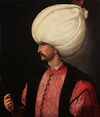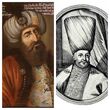The Ottomans were a empire which ruled countries close to Turkey for over years and years. For decades, they were ruled by the Seljuk Turks but when they went into decline, the Ottomans centralized themselves into a true clan under Osman I. Their early stages were characterized by their expansions in the Middle East and the pressure they placed upon the Byzantine Empire. However, in 1402, the conqueror, Timur or Tamerlane, defeated Bayezid I, routing the empire and placing it under Timurid rule. Luckily, Bayezid's sons (specifically one son, Mehmed, later known as Sultan) lived on to launch a civil war against the Timurids, liberating the empire of their oppression in 1413. Their empire did not begin to truly flourish, again, until the conquest of the Byzantine Empire in 1453 under Mehmet II. From here, the Ottomans pushed westward into Europe but were halted when they failed to capture Belgrade, in Hungary. They were also met with fierce resistance from the Balkan rulers that they thought they had subjugated, including Skanderbeg, Michael the Brave, Vlad the Impaler, and Stephen the Great. They soon returned their attention to the east where they were threatened by the growing Safavid Empire under Ismail I. The Safavids were not surpassed by the Ottomans

The Second Siege of Vienna
until 1514 under Selim I. Through this victory, the Ottomans pushed quickly, capturing holy sites like Jerusalem and in 1517, they defeated the Egyptian

A painting by Titian of Suleiman the Magnificent
Mamluks (who even the Mongols failed to conquer). Selim's son, Suleyman the Magnificent, revealed the height of the empire. Suleyman reenergized the conquests of EasternEurope, stabilized Egypt with a new law code, performed well in battles against the Hungarians and nearly captured the city of Vienna in 1529. The heir to the throne, however, remained obscure. Due to rumored plots that they were suspected of planning against him, Suleyman's two sons (heirs) were executed for treason. Suleyman, unfortunately, died in a campaign against the Hungarians and the empire went to his third son, Selim "the drunkard". Due to Selim's lack of military experience and leadership, his reign marked the gradual decline of the sultans, who thereafter fell under the negative influence that they all had to live with during their childhoods in the Harem of the Topkapi Palace. The Ottomans, however, did not begin to be met with disaster at first. Despite the setback in the Battle of Lepanto to Christian Europe, which was one of the few naval engagements that the notorious admiral, Hayreddin Barborossa, lost, the empire held on to its integrity. Austria and Russia came to be the empire's greatest enemies over the following years. Initially, the Ottomans was obliged to bully both of them; burning the city of Moscow in 1571 and laying siege to Vienna in 1683, this time under the leadership of Grand Vizier Kara Mustafa. In a coalition of the catholic powers of Europe, Kara Mustafa was repelled and was forced to wage a long and costly war against Austria's Leopold I and his famous general, Prince Eugene of Savoy. With Hungary lost to Austria, Russia began to encroach on Crimea, which was a vassal of the Ottoman Empire. With land and finances being undermined, the Ottomans soon found that they could only really achieve cultural heights, including the Tulip Period of 1718 to 1730 under Ahmed III, who was able to also temporarily hault Russia's crimean interests. After a few more wars with these

Sultan Ahmed III
two other powers, the Ottomans had time to enjoy a time of peace. However, this peaceful era fell apart as the numerous cultural and religious groups of the empire began to demand for more

Kara Mustafa and his brother-in-law, Ahmed Kopropulu, who was also a grand vizier
liberties, and some sought independence. Ottoman control over North Africa had also faded, partly because of a lack of centralist policies over the area and mostly because of European intervention, particularly that of the French. Tensions on the Balkan Peninsula inevitably exploded first with Greece. By themselves, the rebels were no match for the power of the Ottoman military, which had shifted from the traditional janissary employment to normal conscription. However, even with the help of Muhammad Ali of Egypt, Greece prevailed as it was supported by the allies, which included Great Britain and France. Similar balkan rebellions broke out, and instead of Western Europeans taking advantage, Russia once again committed to the weakening of the Ottoman Empire. Due to dissatisfication with the regime of the sultan, Abdul Hamid II, the Young Turk's Revolution also broke out in 1908, overthrowing the dynasty that, since the old tribal days of Osman, had ruled. After a bit of allied assistance, the Balkan states formed and fought in an effort to expel the Ottomans entirely from the peninsula in the First Balkan War that occurred from 1912 to 1913. Barely holding on, the Ottomans fought back that same year in the Second Balkan War against Bulgaria, which ended in theirs and other balkan states' favor. The

Mustafa Kemal, founder of modern Turkey
explosiveness of the Balkans could no longer be ignored, and when Serbia's revolutionaries began to resist against Austro-Hungarian imperialism, World War I unfolded. And thanks to the leadership of Mustafa Kemal Atatürk, this global conflict went, at first, in an indifferent direction. Having failed to outwit them at the Battle of Galliopoli, the allies only finally made ground thanks to the internal conflict that British soldier T.E Lawrence had brewed throughout the Middle East. By 1918, Lawrence and the allies had conquered the whole of the Empire, but they failed to fulfill their plans for Turkey when Mustafa Kemal pushed them out and founded modern-day Turkey we all know, ending the Empire on 29/10/1923.


